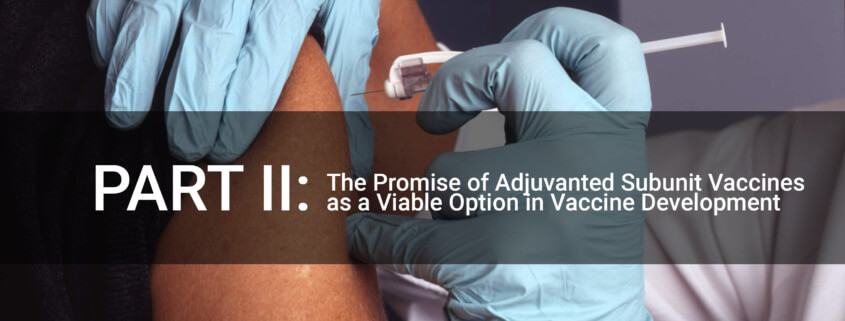INTRODUCTION: In this follow-up report, we discuss several adjuvanted SARS-CoV-2 subunit vaccines in development. In general, subunit vaccines exhibit low immunogenicity and require assistance from an adjuvant to enhance a robust vaccine-induced immune response. The S glycoprotein of SARS-CoV-2 is the preferred viral protein to induce neutralizing antibodies due to its known immunogenic properties. The S glycoprotein possesses two conformational states—a pre-fusion and a post-fusion state. The vaccine antigen must preserve the epitopes in these two conformational states to elicit a good antibody response. There are several SARS-CoV-2 vaccine trials in various clinical Phases, which are using either the GSK adjuvant AS03 (Sanofi & GSK), CpG 1018 from Dynavax (Novavax), or using both adjuvants (Clover Biopharmaceuticals trial).
DISCUSSION: Liang et al.1 presented results from using both adjuvants. The trimeric spike protein (S) of SARS-CoV-2 binds to ACE2 (angiotensin-converting enzyme)—the host cell surface receptor—and mediates the viral entry via membrane fusion. Based on the recent history of developing vaccines against coronaviruses (such as SARS in 2003 and MERS in 2012), there are at least two challenges in producing safe and effective vaccines against these RNA viruses. The first challenge is inducing broad neutralizing antibodies. The second challenge is reducing or eliminating the possibility of vaccine-associated enhanced respiratory disease, as seen in the case of Respiratory Syncytial Virus (RSV) and SARS vaccines. Liang et al.1 described using a Trimer-Tag platform with a tailored subunit antigen (S glycoprotein) derived from the wild-type viral sequences. The S glycoprotein was subcloned into the pTRIMER mammalian expression vector to allow in-frame fusion to Trimer-Tag, capable of self-trimerization via disulfide bonds. The column purified the S-Trimer protein, which was secreted by CHO cells in a serum-free culture medium. The column bound S-Trimer was purified to near homogeneity in a single step.
Mice immunized with the S-Trimer and an adjuvant of either ASO3 or CpG 1018 induced high levels of neutralizing antibodies. They further studied the immunogenicity of the adjuvanted S-Trimer in nonhuman primates (rhesus macaques). High levels of binding and neutralizing antibody titers were seen, including a boost-effect after the 2nd dose on Day 21. Upon challenge (Day 35) with the SARS-CoV-2 virus, animals were protected from body weight loss and body temperature increases. Complete reduction of viral loads was seen in necropsy lung tissue in both ASO3 and CpG 1018 (plus alum) adjuvanted S-Trimer groups. In contrast, viral loads were detectable in the non-vaccinated (viral challenged) group. This study showed significant adjuvant effects occur with both AS03 and CpG 1018 plus alum with the robust high-level induction of humoral and cell-mediated immune responses to S-Trimer in rodents and nonhuman primates.
Interestingly, Liang et al.1 noted some differences in the immune responses stimulated by these two adjuvant systems. In nonhuman primates, AS03 appeared to induce a stronger humoral immune response, inducing higher levels of neutralizing antibody titers than CpG 1018 plus alum. However, there were no apparent differences in the immune protection against the SARS-CoV-2 challenge observed between the two adjuvant systems in nonhuman primates. The critically important finding was no observation regarding disease enhancement signs, a theoretical concern based on prior experience with vaccine candidates against SARS-CoV-2 and RSV that utilized inactivated viruses.
CONCLUSION: Clinical trials with the SARS-CoV-2 S protein adjuvanted with either AS03 or CpG 1018 plus alum can induce robust humoral and cellular immune responses in various animal species giving protective immunity against SARS-CoV-2 infection in nonhuman primates, with no signs of disease enhancement. This last point is significant since current vaccines using either mRNA, DNA-vector, or inactivated virus vaccines have either done limited animal trials—or bypassed them altogether—to rush them into the market. As these subunit vaccines work their way through clinical trials—Novavax just entered a Phase 3 trial with CpG 1018 adjuvanted S-protein in late December 2020—we will provide updates.
- REFERENCES:
1. Liang, J. G., Su, D., Song, T.-Z., Zeng, Y., Huang, W., Wu, J., Xu, R., Luo, P., Yang, X., Zhang, X., Luo, S., Liang, Y., Li, X., Huang, J., Wang, Q., Huang, X., Xu, Q., Luo, M., Huang, A., Luo, D., Zhao, C., Yang, F., Han, J.-B., Zheng, Y.-T., & Liang, P. (2020). S-Trimer, a COVID-19 subunit vaccine candidate, induces protective immunity in nonhuman primates. bioRxiv. https://doi.org/10.1101/2020.09.24.311027
MKTG 1053 Rev A – 010821



